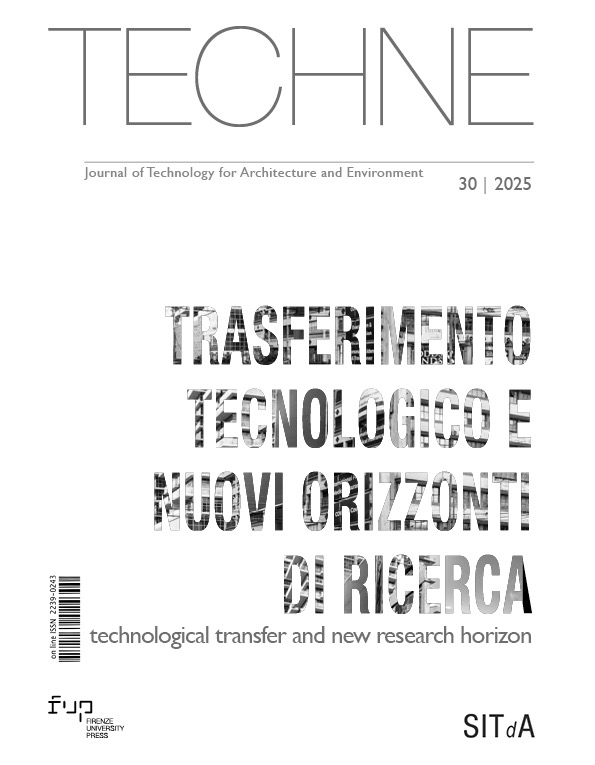Designing Healthy Neighbourhoods: Tools and Networks to Connect Universities, Communities, and Institutions
Published 2025-11-07
Keywords
- House of the Community,
- Healthy Cities,
- Active and Healthy Ageing,
- Co-design,
- Healthy city
How to Cite
Copyright (c) 2025 Nicoletta Setola, Alessandra Rinaldi

This work is licensed under a Creative Commons Attribution 4.0 International License.
Abstract
The paper deals with an example of technology transfer to support decision-making processes for the transformation of the built environment, highlighting the role of the university as a facilitator and innovator of scenarios. The discussion concerns the impacts produced by the research Healthy Neighbourhood Hub, precisely value enhancement of knowledge achieved by connecting different sectors such as architecture, social and health policies; relevance of the results achieved with respect to the local context: peripheral urban area with high deprivation, and the adoption in the Municipal Operational Plan of the conceptual model developed by the research; added value for the beneficiaries: participatory initiatives based on evidence that raise awareness on health-environment, and tools to support the design of the healthy neighbourhood.
Downloads
References
- Baratta, A.F.L., and Calcagnini, L. (2024), “Methods and tools to support the Experimental Programme “Dateci spazio””, TECHNE – Journal of Technology for Architecture and Environment, Vol.28, pp. 280-288. Available at: https://doi.org/10.36253/techne-15852 (Accessed on 24/02/2025). DOI: https://doi.org/10.36253/techne-15852
- Barton, H. and Grant, M. (2006), “A health map for the local human habitat”, Journal of the Royal Society for the Promotion of Health, Vol. 126, n.6, pp. 252–253. Available at: https://doi.org/10.1177/1466424006070466 (Accessed on 24/02/2025). DOI: https://doi.org/10.1177/1466424006070466
- Brambilla, M. e Maciocco G. (2022), Dalle Case della Salute alle Case della Comunità. La sfida del PNRR per la sanità territoriale, Carrocci editore, Roma.
- Busciantella-Ricci, D., Macchi, A., Viviani, S. and Rinaldi, A. (2024), “Healthy and Inclusive Neighbourhoods: A Design Research Toolkit for the Promotion of Healthy Behaviours”, Sustainability, Vol.16, n. 7:3059, pp. 1-35. Available at: https://doi.org/10.3390/su16073059 (Accessed on 24/02/2025). DOI: https://doi.org/10.3390/su16073059
- Fokkinga, S., Desmet, P. and Hekkert, P. (2020), “Impact-centered design: Introducing an integrated framework of the psychological and behavioral effects of design”, International Journal of Design, Vol. 14, n. 3, pp. 97-116. Available at: http://www.ijdesign.org/index.php/IJDesign/article/view/3869 (Accessed on 24/02/2025).
- Hanington, B., and Martin, B. (2019), Universal methods of design expanded and revised: 125 Ways to research complex problems, develop innovative ideas, and design effective solutions, Rockport publishers, Beverly, MA.
- Macchi, A., Busciantella-Ricci, D., Caruso, E. and Setola, N. (2024), “Healthy Neighbourhoods Hub (HNH) Framework: A Practical Guide for Fostering Healthy and Inclusive Living in Florence’s Urban Environment”, Sustainability, Vol. 16, n.11:4423, pp.1-32. Available at: https://doi.org/10.3390/su16114423 (Accessed on 24/02/2025). DOI: https://doi.org/10.3390/su16114423
- Ministero della Salute (2021), Documento di indirizzo per la pianificazione urbana in un’ottica di Salute Pubblica, documento a cura del “Tavolo di lavoro su Città e Salute (Urban Health)” presieduto dal Direttore Generale della Prevenzione Sanitaria del Ministero della Salute. Available at: https://www.salute.gov.it/imgs/C_17_pubblicazioni_3125_allegato.pdf (Accessed on 24/02/2025).
- Rinaldi, A., Viviani, S. and Busciantella-Ricci, D. (2025), “Urban Furniture Design Strategies to Build Healthy and Inclusive Neighborhoods”, Sustainability, Vol. 17, n.3:859, pp. 1-39. Available at: https://doi.org/10.3390/su17030859 (Accessed on 24/02/2025). DOI: https://doi.org/10.3390/su17030859
- Roy, R. and Warren, J. P. (2019), “Card-based design tools – A review and analysis of 155 card decks for designers and designing”, Design Studies, Vol. 63, pp. 125-154. Available at: https://doi.org/10.1016/j.destud.2019.04.002 [Accessed 12/05/2025]. DOI: https://doi.org/10.1016/j.destud.2019.04.002
- Setola, N. and Rinaldi, A. (a cura di) (2024) Progettare un Quartiere Sano. Quaderno 2: Strategie di progetto per un quartiere sano, Didapress, Firenze. Available at: https://didapress.it/pubblicazione/progettare-un-quartiere-sano-strategie-di-progetto-per-un-quartiere-sano (Accessed on 24/02/2025).
- Torricelli, MC (2018), “Healthy City – Healthy Settings Planning. Tra contributo disciplinare e interdisciplinarità”, Ecoweb Town, n.18. Available at: http://www.ecowebtown.it/n_18/18_04.html (Accessed on 24/02/2025).
- WHO-UNHabitat (2016), Global Report on Urban Health: Equitable Healthier Cities for Sustainable Development, World Health Organization, Geneva, Switzerland.






